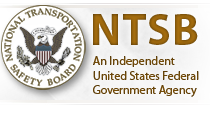EAA Chapter 78 is a 501(c)(3) tax exempt organization (FEIN: 22-1146430). Donations to EAA Chapter 78 are tax deductible to the fullest extent allowed by law. All donations help EAA Chapter 78's educational outreach efforts (Young Eagles, Eagle Flights, etc).
These reports are provided by the National Transportation Safety Board (NTSB). Published as an educational tool. It's intended to help pilots learn from the misfortune(s) of others.
- Braking too aggressively bends plane
Probable Cause: The pilot’s incorrect brake application during the landing roll, resulting in a nose over. - Bad flare leads to bad landing
Probable Cause: The student pilot’s improper landing flare in gusting crosswind conditions, which resulted in a hard, bounced landing. - Go around goes awry
Probable Cause: The pilot's failure to maintain airplane control during the approach and his delayed decision to go around. - Helicopter hits another helicopter while landing
Probable Cause: The pilot’s failure to maintain clearance from a stationary helicopter during landing. Contributing to the accident was the ground crew’s failure to ensure that the helicopter would clear the stationary helicopter. - RV-4 crashes after engine quits
Probable Cause: The total loss of engine power for reasons that could not be determined. - Pilot seriously injured after fuel exhaustion leads to crash
Probable Cause: The pilot’s inadequate preflight fuel planning and in-flight fuel monitoring and his decision to take off with an unverified amount of fuel, which resulted in fuel exhaustion and a subsequent impact with trees during an attempted forced landing. - Car hits Maule aircraft on taxiway
Probable Cause: The ground vehicle driver’s decision to drive on an active taxiway at night and failure to yield to taxiing aircraft, resulting in a collision with a taxiing aircraft. - Quartering tailwind flips Cessna 170
Probable Cause: The pilot’s improper wind correction inputs while taxiing with a quartering tailwind. - Checking phone leads to crash
Probable Cause: The pilot’s diverted attention to his phone while maneuvering at a low altitude, which resulted in collision with terrain. - Pilot inadvertently puts gear up while landing
Probable Cause: The pilot’s inadvertent landing gear retraction during approach. - Crosswind forces plane into lamp post
Probable Cause: The pilot's failure to maintain directional control while taxiing in gusting tailwind conditions. - Distracted pilot hits parked helicopter
Probable Cause: The pilot’s failure to maintain directional control during landing due to being distracted by another airplane and her delayed initiation of a go-around, during which the right wing struck a parked helicopter. - Fuel exhaustion leads to Cessna 150 crash
Probable Cause: The pilot’s improper fuel planning, which resulted in a total loss of engine power due to fuel exhaustion and a subsequent off-airport landing and nose-over. - Snow covered runway leads to accident...
Probable Cause: The pilot’s failure to see the taxiway when returning to the ramp from the snow-covered runway, which resulted in the airplane rolling down an embankment. - Too much brake on landing ends student’s flight
Probable Cause: The student pilot’s failure to maintain directional control during landing. - Pilot looking at iPad hits another plane on the taxiway
Probable Cause: The pilot receiving instruction’s failure to see and avoid an airplane holding short of the runway on the taxiway and the flight instructor’s lack of situational awareness. - Water in the fuel system brings down Cessna 172
Probable Cause: The pilot’s failure to detect water in the fuel system during the preflight inspection, which resulted in a loss of engine power during departure and a subsequent impact with terrain. - Pilot crashes after reaching for iPad on landing
Probable Cause: The pilot’s unnecessary action during the approach, which resulted in a hard landing. - Inoperative fuel gauge results in fuel starvation
"Per Title 14 CFR 91.205, no person may operate a powered civil aircraft with a standard category US airworthiness certificate with an inoperative fuel gauge."
Probable Cause: The pilot’s failure to manage the airplane’s fuel supply, which resulted in fuel starvation. Contributing to the accident was the pilot’s decision to attempt the flight with an inoperative fuel gauge.

